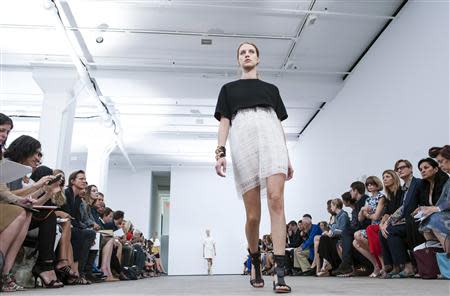Fashion designers unveil what works for work

By Chris Michaud NEW YORK (Reuters) - The latest fashions may look great draped on towering, lithe runway models, but what are top designers offering stylish women who want to look good at work? Professional women have typically looked to designers such as Kenneth Cole, Nicole Miller and Jill Stuart for guidance and wearable options, all of whom showed their spring 2014 collections at New York's Fashion Week. But can their revealing panels and cutouts, leather and lace, all well in evidence on the catwalks this week, be appropriate for the work environment? Absolutely, said Cole, a U.S. American designer known for classically wearable fashions often in black and white. "The workplace is evolving, and workwear is more accepting of street wear," Cole said ahead of his Saturday presentation, which he characterized as "1980's Harlem chic." "It's an extraordinary opportunity," he said of designing fashionable work clothes. "It's always been a priority for me to do cool, comfortable clothes that women can wear to work," he said. "There's no reason that women can't look great and be comfortable looking great." Miller opted to empower women with a show entitled "Rebels With a Cause," bearing the theme "power meets pretty." She made heavy use of prints, patterns, appliques, metallic embroidery and beading, although the collection was virtually devoid of color but for a bit of soft peachy rose and milky blue. Her clothes put a decidedly youthful, feminine and edgy spin on the 1980's notion of power dressing, once typified by stiff constructions and aggressive shoulder pads. Miller played up a sheer fabric she called "power net" and lots of black leather, combined with such items as a chandelier-beaded silk dress. Cole also presented a street-influenced collection, marked by oversized vests over short dresses or paired with pleated trousers or skirts. He used vivid orange and bright, deep greens, often in sequined fabrics with silver and black. Cole said his "evolved urban aesthetic" melded streetwear, leisurewear and sportswear, noting that flexibility was endemic to his separates. "No one has the opportunity to go home and change," he said. "People consume fashion in a way that they never did before." Tadashi Shoji showed a romantic, "sweet liberation"-themed collection in pale pink, ivory, yellow, lavender and mint green. "Women's liberation in the 60s and 80s, women wore power suits," he said. "I think women became so confident and they can show their femininity and sweetness." Rebecca Minkoff, a favorite of the younger set, showed floral dresses, mixed with plaids, and featured a plentitude of embroidery in her high energy show. Jill Stuart, meanwhile, wielded a tougher edge, with functional, sporty looks using black leather and eschewing embellishment. Cutouts and panels, lace and brocade made subtle statements in a collection rendered almost entirely in black, whites and gray. Stuart also emphasized shoulders, either bare in halter tops or accentuated with rounded construction. Cynthia Rowley offered a bit of almost everything. Dresses ranged from minis to well below the knee, and fabrics included large florals, horizontal stripes and solids. Colors were midnight blue, pinks, purples, greens and the ubiquitous black and white. Her native and nature-inspired fabrics were sculpted, quilted, embossed with flowers and decorated with plumed creatures and sequin-and-feather decoupage. With offerings spanning flowing gauze to studded leather, Neiman Marcus fashion director Ken Downing said: "What is a career anymore?" Women in many different industries have changed the idea of "what career dressing is," he said, adding that regardless, "Women are on the go." (Additional reporting by Elly Park and Ellen Wulfhorst; Editing by Ellen Wulfhorst and Diane Craft)

